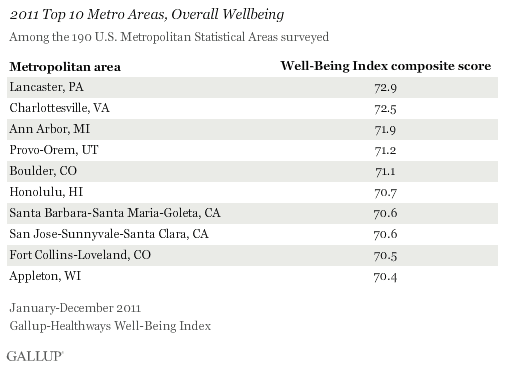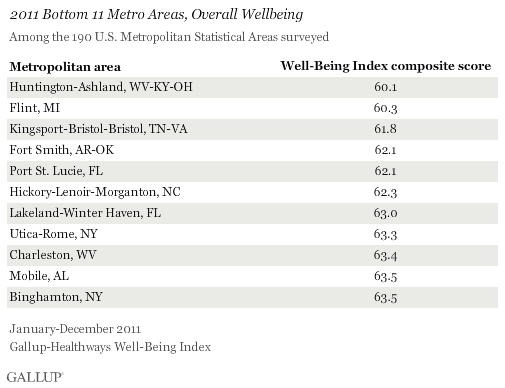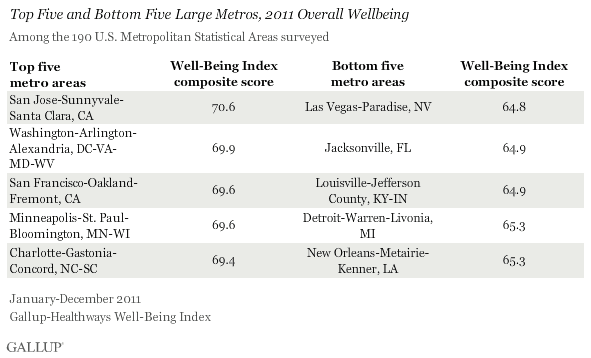WASHINGTON, D.C. -- Lancaster, Pa., had the highest Well-Being Index score in the U.S. across the 190 metropolitan areas that Gallup and Healthways surveyed in 2011. Four university towns -- Charlottesville, Va., Ann Arbor, Mich., Provo-Orem, Utah, and Boulder, Colo. -- round out the top five metro areas with the highest well-being.

Huntington-Ashland, W.Va.-Ky.-Ohio, had the lowest Well-Being Index score for the second year in a row. Its score of 60.1, however, was up from the 58.1 measured in 2010, which at that time was the only score below 60 in the nation.

The regional breakdown in well-being scores is largely consistent with Gallup and Healthways state-level results, which find well-being generally higher in the West and lower in the South. Three states had two cities apiece in the bottom 11, including Florida (Port St. Lucie and Lakeland-Winter Haven), New York (Utica-Rome and Binghamton), and West Virginia (Huntington-Ashland and Charleston).
The "cities" this article references are based on the Metropolitan Statistical Areas (MSAs) as defined by the U.S. Office of Management and Budget. In many cases, more than one city is included in the same MSA. All reported MSAs require at least 300 completed surveys.
The Gallup-Healthways Well-Being Index score is an average of six sub-indexes, which individually examine life evaluation, emotional health, work environment, physical health, healthy behaviors, and access to basic necessities. The overall score and each of the six sub-index scores are calculated on a scale from 0 to 100, where a score of 100 represents the ideal. Gallup and Healthways have been tracking these measures daily since January 2008.
Ann Arbor Tops List in Life Evaluation
Residents of Ann Arbor rate their current lives and their lives in five years the best on a ladder scale with steps numbered from 0 to 10 based on the Cantril Self-Anchoring Striving Scale, giving the city the highest Life Evaluation Index score in the nation. Honolulu again led the nation with the best Emotional Health Index score, while Fort Collins, Colo., displaced a fellow Colorado city, Boulder, with the highest Physical Health Index score in the nation. Prescott, Ariz., had the highest Work Environment Index score, and residents living in Barnstable Town, Mass., had the highest Healthy Behaviors Index score. Appleton, Wis., which did not have a sufficient number of respondents to be reported in previous years, led the nation in residents with the best access to basic necessities.

Residents of Hickory-Lenoir-Morganton, N.C., rated their lives about half as well as those in Ann Arbor. Similarly, residents of Flint, Mich., reported only half of the workplace well-being found in Prescott.
Huntington-Ashland residents again reported the worst physical health, although the city's score of 67.8 is an improvement over the 64.6 measured in 2010, which at the time was more than six points lower than the next lowest city's score. These results align with West Virginia's position as the most obese state.
Kingsport-Bristol, Tenn.-Va., had the worst Emotional Health Index score, bumping Huntington-Ashland from the worst in 2010 to second worst in the rankings this year. Healthy behaviors were least prevalent in Fort Smith, Ark.-Okla., which ranked last in overall well-being among all cities in 2009. McAllen-Edinburg-Mission, Texas, residents reported the worst access to basic necessities for the third year in a row, due in part to 49.3% of residents who reported lacking health insurance, by far the lowest in the nation. Coupled with El Paso in 2008, the state of Texas has lowest scoring city in the U.S. in the Basic Access Index for all four years of measurement.
San Jose, Calif., and Washington, D.C., Have Highest Well-Being Among Large Cities
San Jose-Sunnyvale-Santa Clara, Calif., residents reported the highest well-being among the nation's 52 largest metropolitan areas, those with 1 million or more residents, followed by Washington, D.C.-Arlington-Alexandria, Va.-Md.-W.Va. These two cities have been in the top three among large metro areas each of the past three years.
Las Vegas, Nev., had the lowest well-being among large cities, though its score was not dramatically lower than those near the top. Las Vegas' relatively lower score was driven heavily by its low basic access scores, including the fifth worst score in access to clean and safe water among all cities in the nation.

Implications
High well-being cities provide good examples for other metropolitan areas to follow in the pursuit of more emotionally, physically, and financially secure citizenries. These cities have the well-being foundation for economic success and illustrate the relevance of local interventions and local solutions that are crucial to long-term viability.
Lancaster, for example, is third best in the nation for working residents that have supervisors that partner with them. This form of relationship between workers and their supervisors can lead to decreased chances of poor health and less susceptibility to the potential negative effects of long commutes.
Charlottesville is No. 1 in the nation for residents treating one another with respect, suggesting an underlying culture of shared purpose and commonwealth.
More than four-fifths (81%) of Boulder residents reported going to the dentist at least once a year, better than any other city in America. When combined with other risk factors, poor oral health can be linked to heart disease, stroke, atherosclerosis, rheumatoid arthritis, diabetes, and preterm births. Boulder, along with Provo and Ann Arbor, are among the top cities in America for "learning new and interesting things," which is a common feature of high well-being cities and may reflect the influence of local universities and colleges.
The San Jose-Sunnyvale-Santa Clara metro area is 10th best among all cities and first among large metro areas for providing its residents with "safe places to exercise," thereby ensuring that anyone who wants to commit him or herself to a more physically fit lifestyle is secure in doing so. Nearly all residents (96%) of this metro area agreed with this statement.
These high-level results provide a sampling of what the Gallup-Healthways Well-Being Index metrics reveal about U.S. cities. Even the metro areas with the highest overall well-being have specific areas in need of improvement, and those with the lowest overall well-being have strengths that leaders can celebrate or develop to inspire improvement in other areas. By understanding these strengths and weaknesses, leaders can make better strategic and tactical decisions to affect positive change in their communities, improving individual lives and the nation overall.
About the Gallup-Healthways Well-Being Index
The Gallup-Healthways Well-Being Index tracks well-being in the U.S., U.K., and Germany and provides best-in-class solutions for a healthier world.
Survey Methods
Results are based on telephone interviews conducted as part of the Gallup-Healthways Well-Being Index survey Jan. 2-Dec. 29, 2011, with a random sample of 353,492 adults, aged 18 and older, living in all 50 U.S. states and the District of Columbia, selected using random-digit-dial sampling.
The metro areas referenced in this article are based on the Metropolitan Statistical Areas (MSAs) as defined by the U.S. Office of Management and Budget. In many cases, more than one city is included in the same MSA. The San Jose, Calif., metropolitan statistical area, for example, also includes the smaller nearby cities of Sunnyvale and Santa Clara in addition to San Jose itself. Each respondent is attributed to his or her MSA based on the self-report of his or her ZIP code, and all metro areas had at least 300 completed surveys in 2011.
Maximum expected error ranges for the MSAs vary according to size, ranging from less than 1 percentage point for the largest cities represented to ±6.5 percentage points for the smallest cities.
Interviews are conducted with respondents on landline telephones and cellular phones, with interviews conducted in Spanish for respondents who are primarily Spanish-speaking. Each sample includes a minimum quota of 400 cell phone respondents and 600 landline respondents per 1,000 national adults, with additional minimum quotas among landline respondents by region. Landline telephone numbers are chosen at random among listed telephone numbers. Cell phone numbers are selected using random-digit-dial methods. Landline respondents are chosen at random within each household on the basis of which member had the most recent birthday.
Samples are weighted by gender, age, race, Hispanic ethnicity, education, region, adults in the household, and phone status (cell phone only/landline only/both, cell phone mostly, and having an unlisted landline number). Demographic weighting targets are based on the March 2010 Current Population Survey figures for the aged 18 and older non-institutionalized population living in U.S. telephone households. All reported margins of sampling error include the computed design effects for weighting and sample design.
In addition to sampling error, question wording and practical difficulties in conducting surveys can introduce error or bias into the findings of public opinion polls.
For more details on Gallup's polling methodology, visit www.gallup.com.
